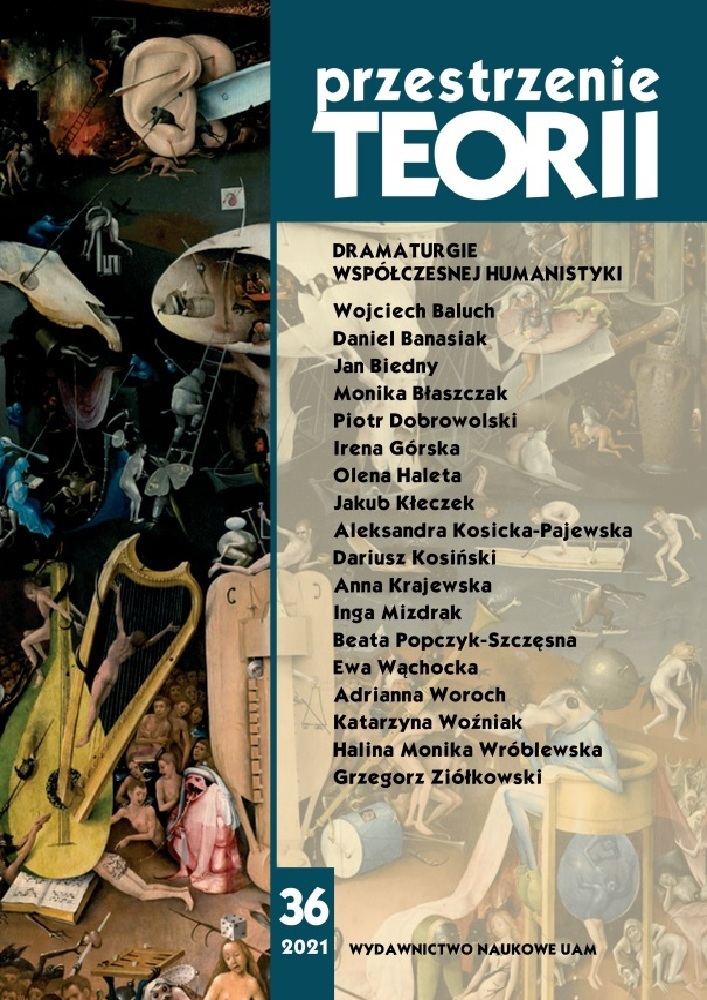Abstrakt
In her paper, Ewa Wąchocka examines the phenomenon of recent dramatic works becoming increasingly more ‘musical’ and the terminological shift it brought about, i.e. the inclusion of the term ‘musical dramaturgy’ in writing for the stage. The author argues that far from being limited to the sounds of speech and language in general, musicality also encompasses a variety of non-musical sounds, the unravelling of the play’s narrative and the psychological makeup of its characters; it also penetrates deeply into the structure of the text. In the analysis of plays by W. Murek, A. Grzegorzewska, and S. Bogacz, the author demonstrates how essential the inspirations sourced from musical culture are for recent dramatic works: the 20th-century experiments with music, the discovery of how potent sound expression can be, or the most technologically advanced methods of sound reproduction. By presenting the many and varied dramatic strategies, the author shows that contemporary playwrights not only use musicality to represent the sound landscape of the world but, first and foremost, to create the ontology of an internally conflicted world.
Bibliografia
Berger K., Narracja i liryka, [w:] Interdisciplinary Studies in Musicology, red. J. Stęszewski, M. Jabłoński, Poznań 1993.
Bruns G.L., Disappeared: Heidegger and the Emancipation of Language: The Play of Negativity in Literature and Literary Theory, red. S. Budick, W. Iser, Columbia University Press, New York 1989.
Chęćka-Gotkowicz A., Persona (non) grata. Czy muzyka absolutna potrzebuje narratora?, „Aspekty Muzyki” 2013, t. 3.
Cone E.T., The Composer’s Voice, University of California Press, Berkeley 1974, s. 5.
Dahlhaus C., Estetyka muzyki, przeł. Z. Skowron, Warszawa 2014.
Davies S., The Expression of Emotion in Music, „Mind” 1980, nr 89.
Fischer-Lichte E., Estetyka performatywności, przeł. M. Borowski, M. Sugiera, Kraków 2008.
Grzegorzewska A., Za mało, „Dialog” 2017, nr 1.
Karasińska M., Muzyka i dramat. Razem czy osobno, [w:] eadem, Zapiski z teorii teatru, Poznań 2020.
Kawin B.F., Telling It Again and Again. Repetition in Literature and Film, Cornell University Press, Ithaca and London 1972.
Levonson J., Music as Narrative and Music as Drama, „Mind and Language” 2004, nr 19 (4).
Maus F.E., Music as Drama, [w:] Music and Meaning, red. J. Robinson, Cornell University Press, Ithaca and London 1997.
Murek W., Feinweinblein, „Dialog” 2015, nr 7–8.
Ovadija M., Dramaturgy of Sound in the Avant-garde and Postdramatic Theatre, Mcgill-Queen’s University Press, Montreal 2013.
Pawłowska M., Narracja a muzyka: o globalnym „efekcie narratologicznym” i jego konsekwencjach w myśli o muzyce, „Kultura Współczesna” 2014, nr 3.
Rudzka Z., Zimny bufet, Kraków 2012.
Ryzyko stymuluje uwagę. Rozmowa W. Malinowskiego z J. Ostaszewskim, „Notatnik Teatralny” 1999, nr 18–19.
Schafer R.M., I Have Never Seen a Sound, „Environmental and Architectural Phenomenology” 2006, vol. 17, no. 2.
Skowron Z., Estetyka sformułowana Witolda Lutosławskiego, [w:] Estetyka i styl twórczości Witolda Lutosławskiego, red. Z. Skowron, Kraków 2000.
Szymańska-Stułka K., Muzyka i scena. O muzycznej teatralności – Les espaces du sommeil Witolda Lutosławskiego, [w:] Gangliony pękają mi od niewyrażalnych myśli, red. M. Hasiuk, A. Winch, Warszawa 2019.
Tomaszewski M., Narracja dzieła muzycznego jawna i domyślna, poufna i tajemna, „Polski Rocznik Muzykologiczny” 2017, XV, s. 201.
Licencja
Autorzy
Autorzy tekstów przyjętych do publikacji w czasopiśmie „Przestrzeniach Teorii” są zobowiązani do wypełnienia, podpisania i odesłania na adres redakcji umowy o udzielenie nieodpłatnej licencji do utworów, z zobowiązaniem do udzielania sublicencji CC.
Zgodnie z umową, autorzy tekstów opublikowanych w czasopiśmie „Przestrzeniach Teorii” udzielają Uniwersytetowi im. Adama Mickiewicza w Poznaniu niewyłącznej i nieodpłatnej licencji oraz zezwalą na użycie sublicencji Creative Commons Attribution-NonCommercial-NoDerivatives 4.0 International (CC BY-NC-ND 4.0).
Autorzy zachowują prawa do dalszego, swobodnego rozporządzania utworem.
Autorzy, którzy wykorzystują w swoim tekście cudze utwory (np. ilustracje, fotografie) proszeni są o dostarczenie do redakcji czasopisma zgodę na publikację od uprawnionych podmiotów.
Użytkownicy
Zainteresowani użytkownicy internetu uprawnieni są do korzystania z utworów opublikowanych po 2015 roku „Przestrzeniach Teorii” tylko w calach niekomercyjnych, pod następującymi warunkami:
- uznanie autorstwa - obowiązek podania wraz z rozpowszechnionym utworem, informacji, o autorstwie, tytule, źródle (odnośniki do oryginalnego utworu, DOI) oraz samej licencji;
- bez tworzenia utworów zależnych - utwór musi być zachowany w oryginalnej postaci, nie można bez zgody twórcy rozpowszechniać np. tłumaczeń, opracowań.
Do wszystkich tekstów opublikowanych przed 2015 r. prawa autorskie są zastrzeżone.
Inne
Uniwersytet im. Adama Mickiewicza w Poznaniu zachowuje prawo do czasopisma jako całości (układ, forma graficzna, tytuł, projekt okładki, logo itp.).

